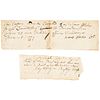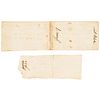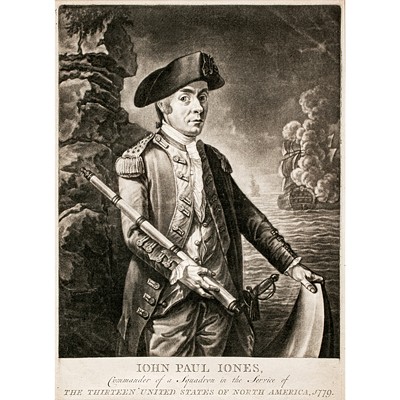1777 Siege of Fort Ticonderoga + Battle of Bennington related Pair of Documents
Lot 84
Categories
Estimate:
$600 - $900
Absentee vs Live bid
Two ways to bid:
- Leave a max absentee bid and the platform will bid on your behalf up to your maximum bid during the live auction.
- Bid live during the auction and your bids will be submitted real-time to the auctioneer.
Bid Increments
| Price | Bid Increment |
|---|---|
| $0 | $10 |
| $200 | $20 |
| $300 | $25 |
| $500 | $50 |
| $1,000 | $100 |
| $2,000 | $200 |
| $3,000 | $250 |
| $5,000 | $500 |
| $10,000 | $1,000 |
| $20,000 | $2,000 |
| $30,000 | $2,500 |
| $50,000 | $5,000 |
| $100,000 | $10,000 |
| $200,000 | $20,000 |
| $300,000 | $25,000 |
| $500,000 | $50,000 |
About Auction
By Early American History Auctions
Jan 23, 2021
Set Reminder
2021-01-23 12:00:00
2021-01-23 12:00:00
America/New_York
Bidsquare
Bidsquare : Early American History Auction of Autographs, Americana, Political & Maps
https://www.bidsquare.com/auctions/early-american-history-auctions/early-american-history-auction-of-autographs-americana-political-maps-6311
311 Lots of Rare, Historic Autographs, Americana, Civil War Era, George Washington, Abraham Lincoln, Slavery & Black History, Revolutionary War Era, Colonial America, Federal Period, War of 1812, Colonial Currency, Indian Peace Medals & more... Early American History Auctions auctions@earlyamerican.com
311 Lots of Rare, Historic Autographs, Americana, Civil War Era, George Washington, Abraham Lincoln, Slavery & Black History, Revolutionary War Era, Colonial America, Federal Period, War of 1812, Colonial Currency, Indian Peace Medals & more... Early American History Auctions auctions@earlyamerican.com
- Lot Description
American Revolution
Pair of Revolutionary War Requisition Forms for Supplies and Arms to Draw Provisions 25 Men & Officers at Fort Ticonderoga
1777-dated Revolutionary War, Two Manuscript Requisition Forms for supplies and arms including, "...Provisions Contains 25 men Including officers Ticonderoga, June 6, 1777," and July 10th, 1777 at Bennington (VT.), both Very Fine.
Siege of Fort Ticonderoga and Battle of Bennington related Pair of Interesting Documents. These were for record-keeping and command of "Supply" chains, even in the chaotic conditions of the requirements of the battlefield in The American Revolutionary War.
1. 2.5" x 8", June 6, 1777 at Ticonderoga: "The Company under the Command of Lt. James Blake in Col. Leonards Regt to Draw Provisions Contains 25 men Including officers Ticonderoga June 6, 1777 - (Signed) James Blake Lt." Just prior to the historic 1777 Siege of Fort Ticonderoga occurred between 2 and 6 July 1777 at Fort Ticonderoga, by General John Burgoyne's 8,000-man army that occupied high ground above the fort, and nearly surrounded the defenses. These movements precipitated the occupying Continental Army, an under-strength force of 3,000 under the command of General Arthur St. Clair, to withdraw from Ticonderoga and the surrounding defenses.
2. 2" x 5.25", "Bennington July 10th 1777, Recd of Lieu Benj. Winchel two guns which he drawd out of Continental Stores. I say Recd by me - (Signed) Benj. Fay Ensign." The Battle of Bennington was a battle of the American Revolutionary War, part of the Saratoga campaign, that took place on August 16, 1777, in Walloomsac, New York, about 10 miles (16 km) from its namesake Bennington, Vermont. The Battle of Bennington was the precursor to the defeat of British General John Burgoyne's army two months later at Saratoga, turning the tide of war in favor of the Americans.
(2 items)
The 1777 Siege of Fort Ticonderoga occurred between 2 and 6 July 1777 at Fort Ticonderoga, near the southern end of Lake Champlain in the state of New York. Lieutenant General John Burgoyne's 8,000-man army occupied high ground above the fort, and nearly surrounded the defenses.
These movements precipitated the occupying Continental Army, an under-strength force of 3,000 under the command of General Arthur St. Clair, to withdraw from Ticonderoga and the surrounding defenses. Some gunfire was exchanged, and there were some casualties, but there was no formal siege and no pitched battle. Burgoyne's army occupied Fort Ticonderoga and Mount Independence, the extensive fortifications on the Vermont side of the lake, without opposition on 6 July. Advance units pursued the retreating Americans.
The uncontested surrender of Ticonderoga caused an uproar in the American public and in its military circles, as Ticonderoga was widely believed to be virtually impregnable, and a vital point of defense. General St. Clair and his superior, General Philip Schuyler, were vilified by Congress. Both were eventually exonerated in courts martial, but their careers were adversely affected. Schuyler had already lost his command to Horatio Gates by the time of the court martial, and St. Clair held no more field commands for the remainder of the war.
- Shipping Info
-
Early American provides in-house worldwide shipping. Please contact us directly if you have questions about your specific shipping requirements.
-
- Buyer's Premium



 EUR
EUR CAD
CAD AUD
AUD GBP
GBP MXN
MXN HKD
HKD CNY
CNY MYR
MYR SEK
SEK SGD
SGD CHF
CHF THB
THB












